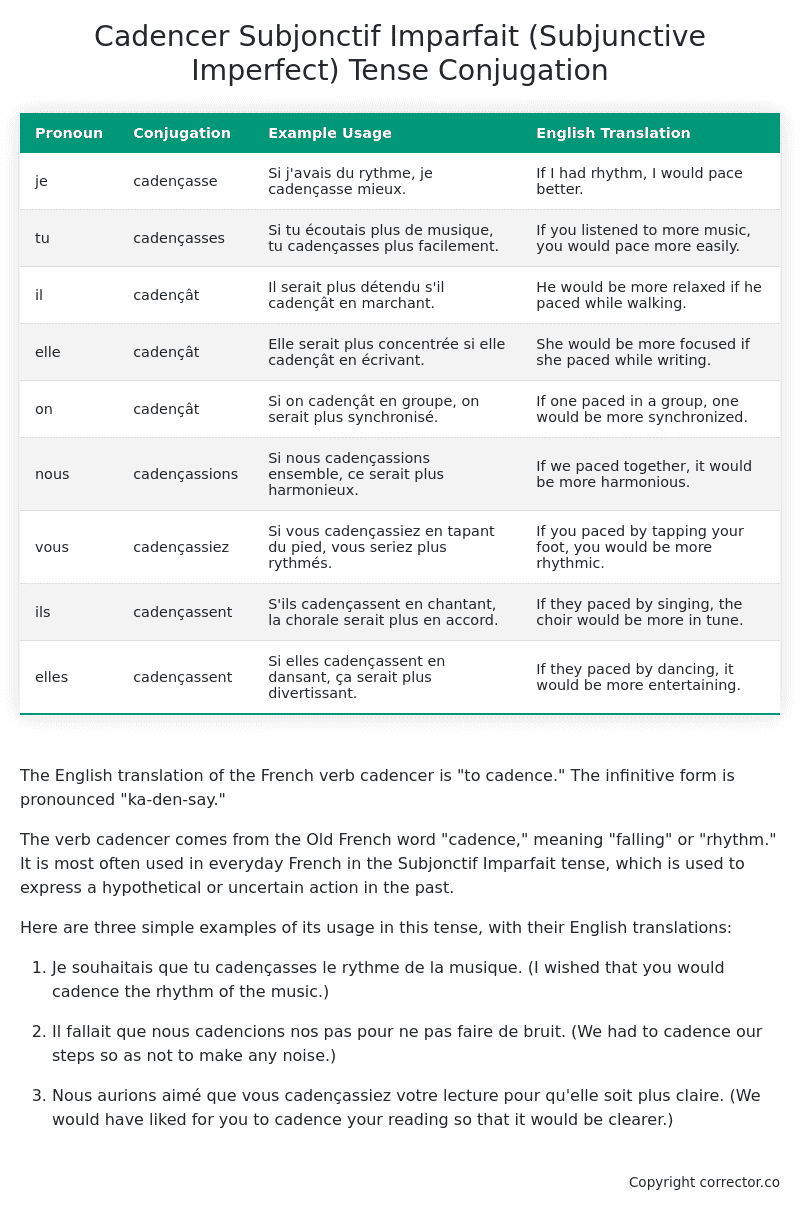Subjonctif Imparfait (Subjunctive Imperfect) Tense Conjugation of the French Verb cadencer
Introduction to the verb cadencer
The English translation of the French verb cadencer is “to cadence.” The infinitive form is pronounced “ka-den-say.”
The verb cadencer comes from the Old French word “cadence,” meaning “falling” or “rhythm.” It is most often used in everyday French in the Subjonctif Imparfait tense, which is used to express a hypothetical or uncertain action in the past.
Here are three simple examples of its usage in this tense, with their English translations:
-
Je souhaitais que tu cadençasses le rythme de la musique. (I wished that you would cadence the rhythm of the music.)
-
Il fallait que nous cadencions nos pas pour ne pas faire de bruit. (We had to cadence our steps so as not to make any noise.)
-
Nous aurions aimé que vous cadençassiez votre lecture pour qu’elle soit plus claire. (We would have liked for you to cadence your reading so that it would be clearer.)
Table of the Subjonctif Imparfait (Subjunctive Imperfect) Tense Conjugation of cadencer
| Pronoun | Conjugation | Example Usage | English Translation |
|---|---|---|---|
| je | cadençasse | Si j’avais du rythme, je cadençasse mieux. | If I had rhythm, I would pace better. |
| tu | cadençasses | Si tu écoutais plus de musique, tu cadençasses plus facilement. | If you listened to more music, you would pace more easily. |
| il | cadençât | Il serait plus détendu s’il cadençât en marchant. | He would be more relaxed if he paced while walking. |
| elle | cadençât | Elle serait plus concentrée si elle cadençât en écrivant. | She would be more focused if she paced while writing. |
| on | cadençât | Si on cadençât en groupe, on serait plus synchronisé. | If one paced in a group, one would be more synchronized. |
| nous | cadençassions | Si nous cadençassions ensemble, ce serait plus harmonieux. | If we paced together, it would be more harmonious. |
| vous | cadençassiez | Si vous cadençassiez en tapant du pied, vous seriez plus rythmés. | If you paced by tapping your foot, you would be more rhythmic. |
| ils | cadençassent | S’ils cadençassent en chantant, la chorale serait plus en accord. | If they paced by singing, the choir would be more in tune. |
| elles | cadençassent | Si elles cadençassent en dansant, ça serait plus divertissant. | If they paced by dancing, it would be more entertaining. |
Other Conjugations for Cadencer.
Le Present (Present Tense) Conjugation of the French Verb cadencer
Imparfait (Imperfect) Tense Conjugation of the French Verb cadencer
Passé Simple (Simple Past) Tense Conjugation of the French Verb cadencer
Passé Composé (Present Perfect) Tense Conjugation of the French Verb cadencer
Futur Simple (Simple Future) Tense Conjugation of the French Verb cadencer
Futur Proche (Near Future) Tense Conjugation of the French Verb cadencer
Plus-que-parfait (Pluperfect) Tense Conjugation of the French Verb cadencer
Passé Antérieur (Past Anterior) Tense Conjugation of the French Verb cadencer
Futur Antérieur (Future Anterior) Tense Conjugation of the French Verb cadencer
Subjonctif Présent (Subjunctive Present) Tense Conjugation of the French Verb cadencer
Subjonctif Passé (Subjunctive Past) Tense Conjugation of the French Verb cadencer
Subjonctif Imparfait (Subjunctive Imperfect) Tense Conjugation of the French Verb cadencer (this article)
Subjonctif Plus-que-parfait (Subjunctive Pluperfect) Tense Conjugation of the French Verb cadencer
Conditionnel Présent (Conditional Present) Tense Conjugation of the French Verb cadencer
Conditionnel Passé (Conditional Past) Tense Conjugation of the French Verb cadencer
L’impératif Présent (Imperative Present) Tense Conjugation of the French Verb cadencer
L’infinitif Présent (Infinitive Present) Tense Conjugation of the French Verb cadencer
Struggling with French verbs or the language in general? Why not use our free French Grammar Checker – no registration required!
Get a FREE Download Study Sheet of this Conjugation 🔥
Simply right click the image below, click “save image” and get your free reference for the cadencer Subjonctif Imparfait tense conjugation!

Cadencer – About the French Subjonctif Imparfait (Subjunctive Imperfect) Tense
Formation
Common Everyday Usage Patterns
Interactions with Other Tenses
Subjonctif Présent
Indicatif Passé Composé
Conditional
Conditional Perfect
Summary
I hope you enjoyed this article on the verb cadencer. Still in a learning mood? Check out another TOTALLY random French verb conjugation!


